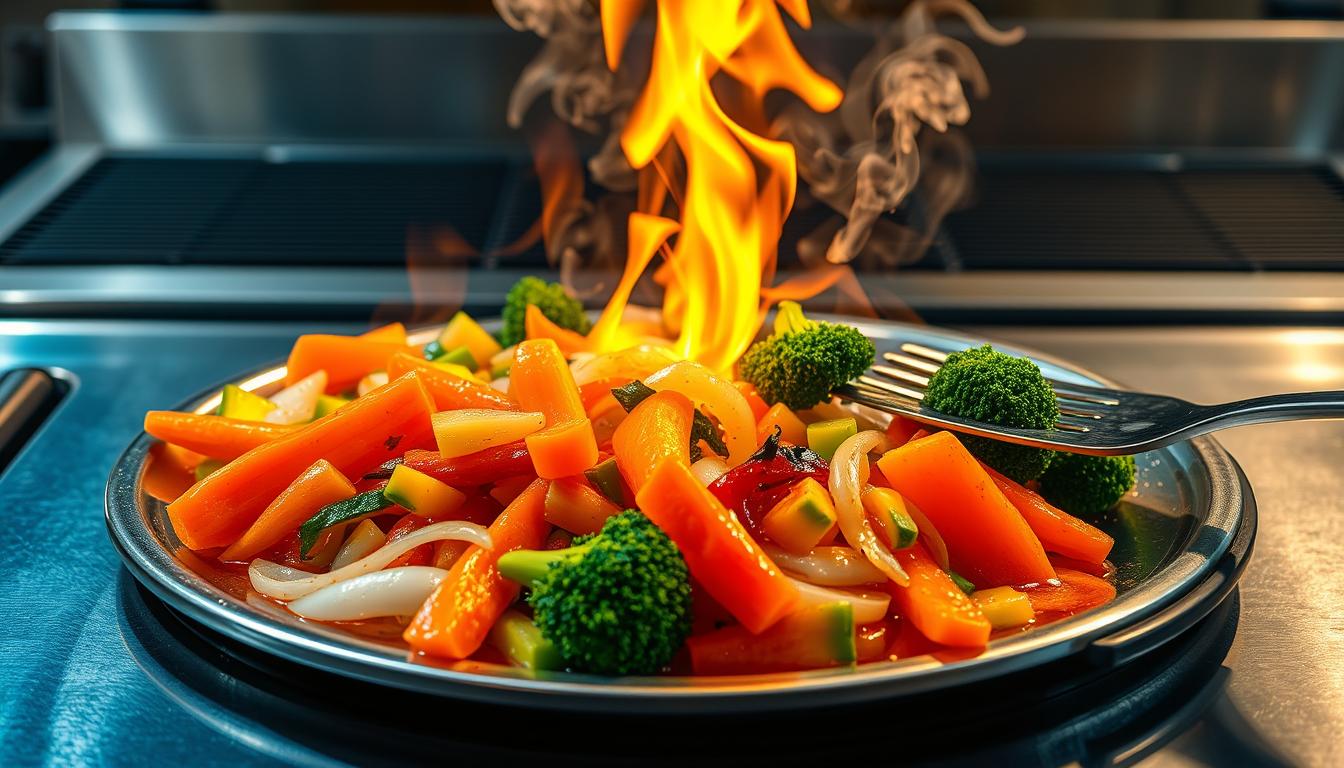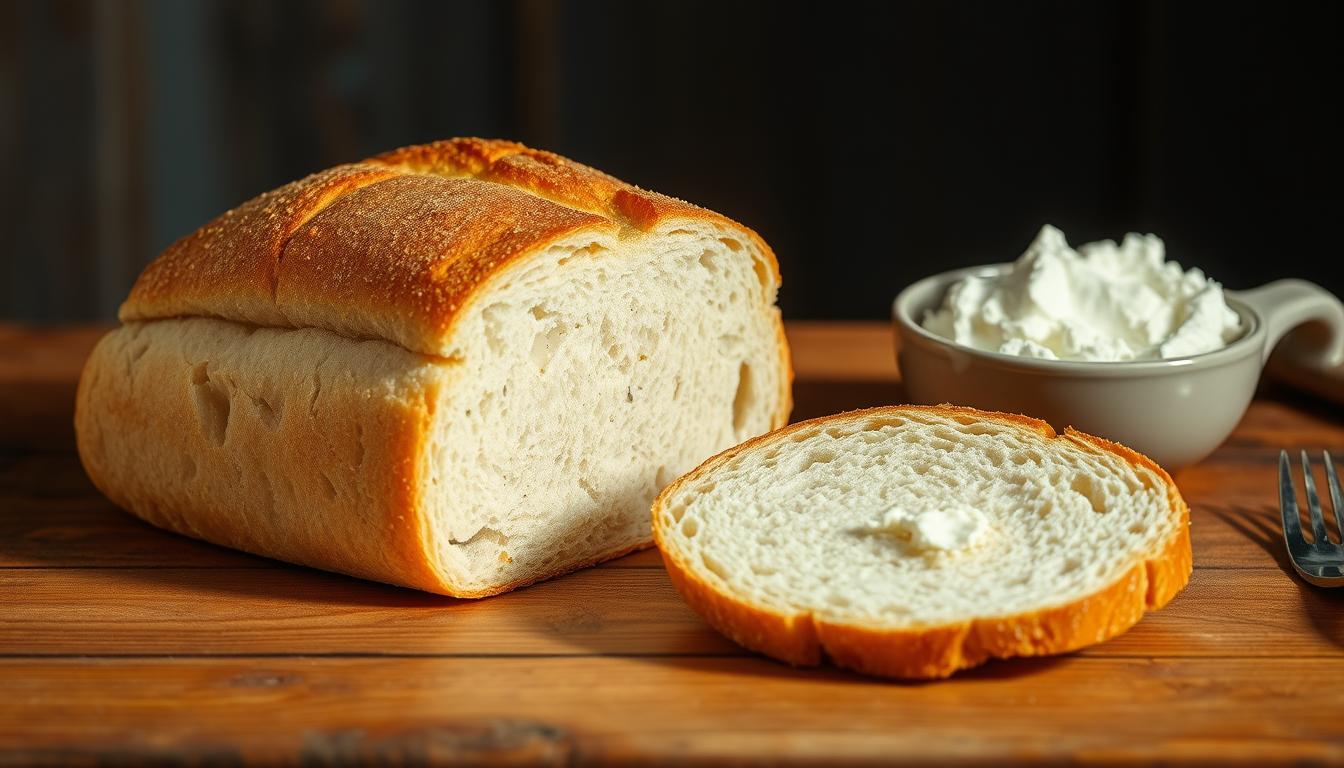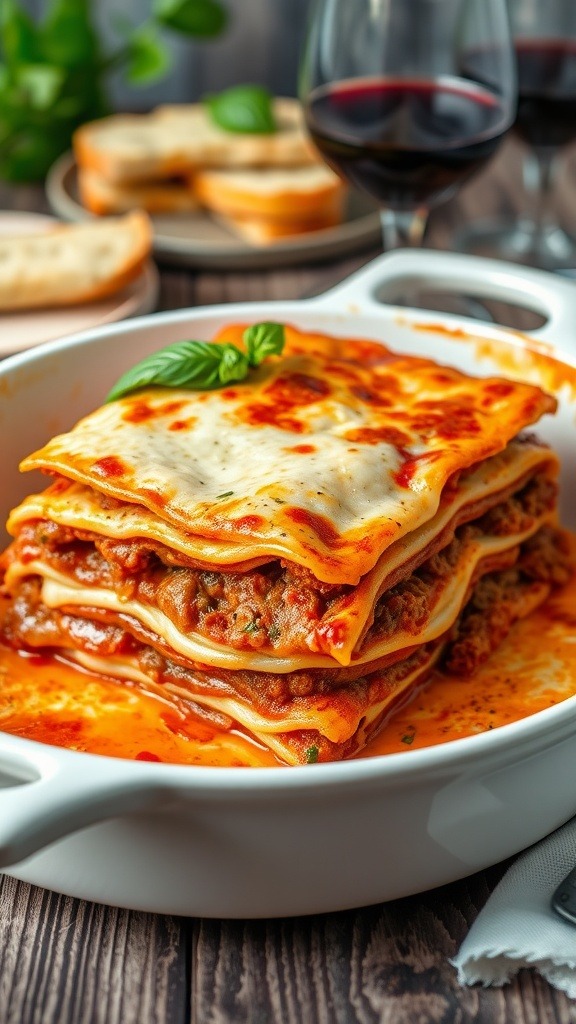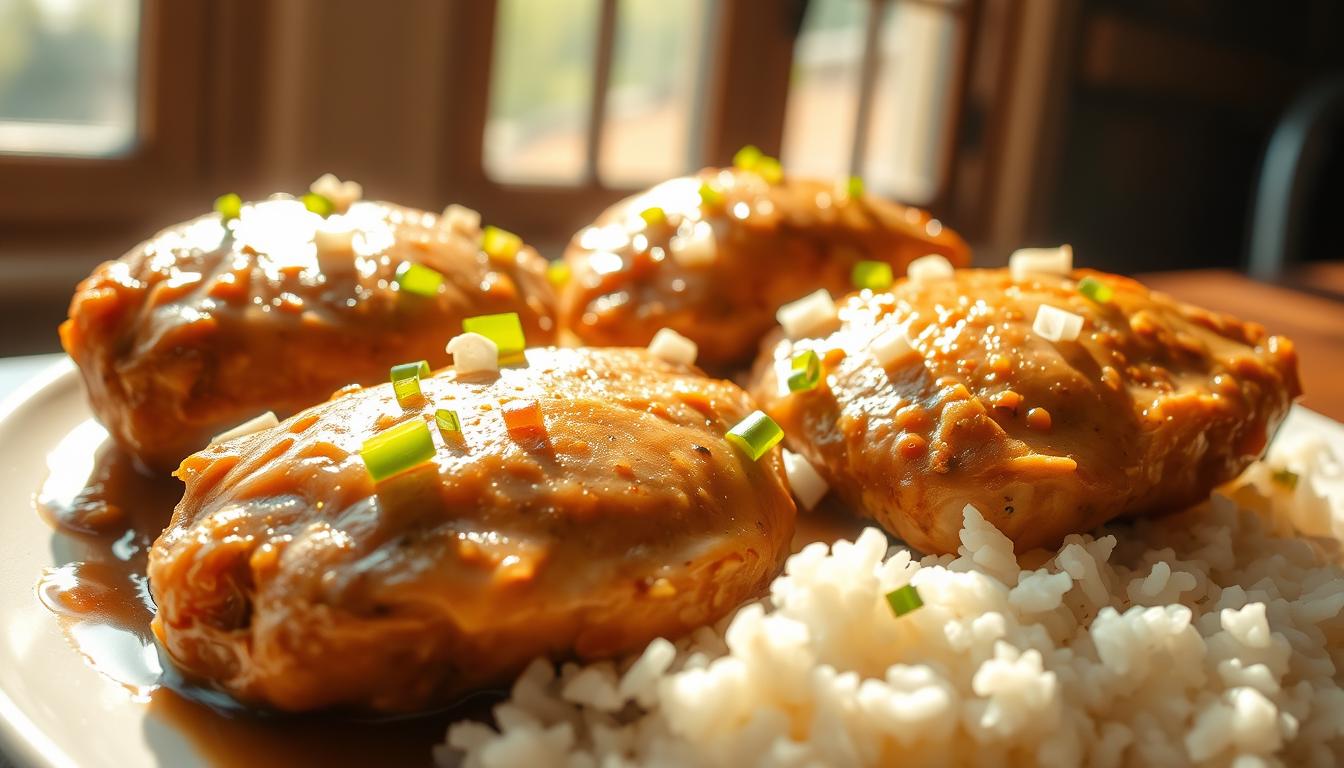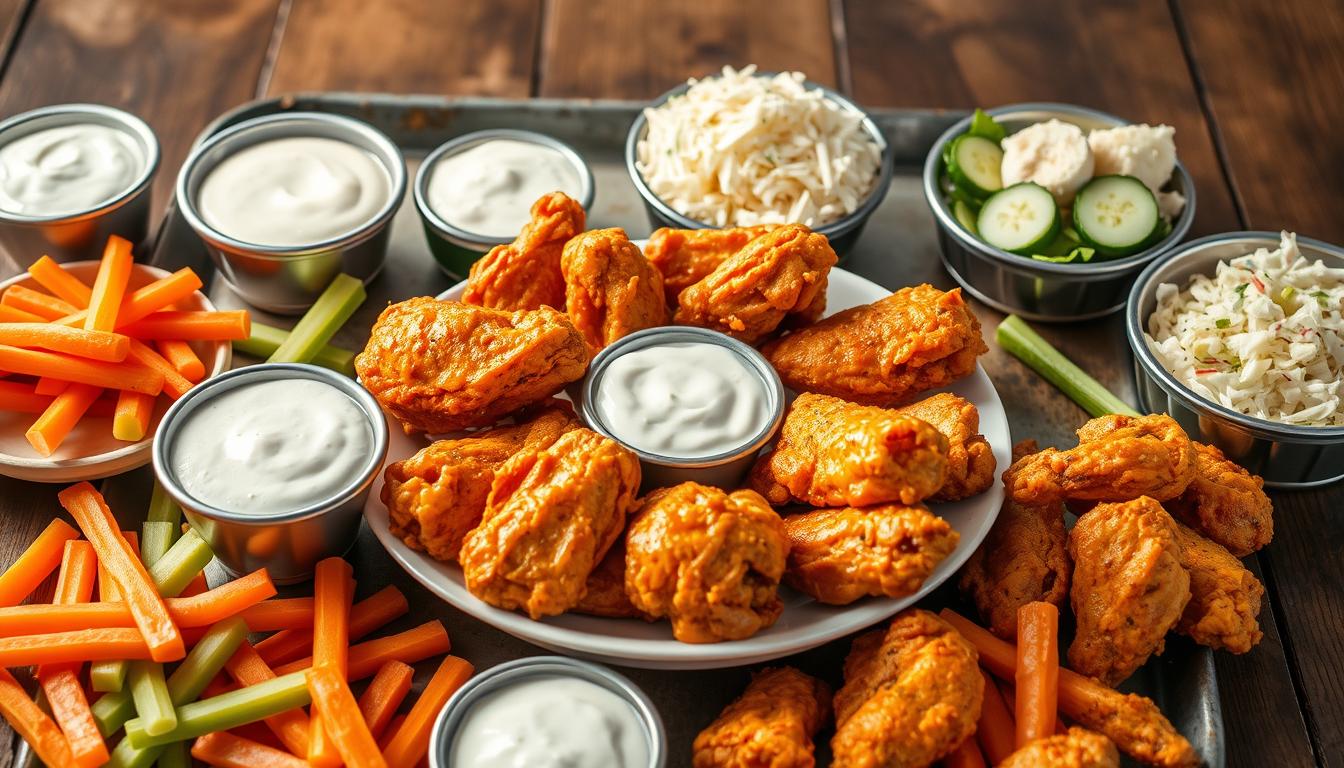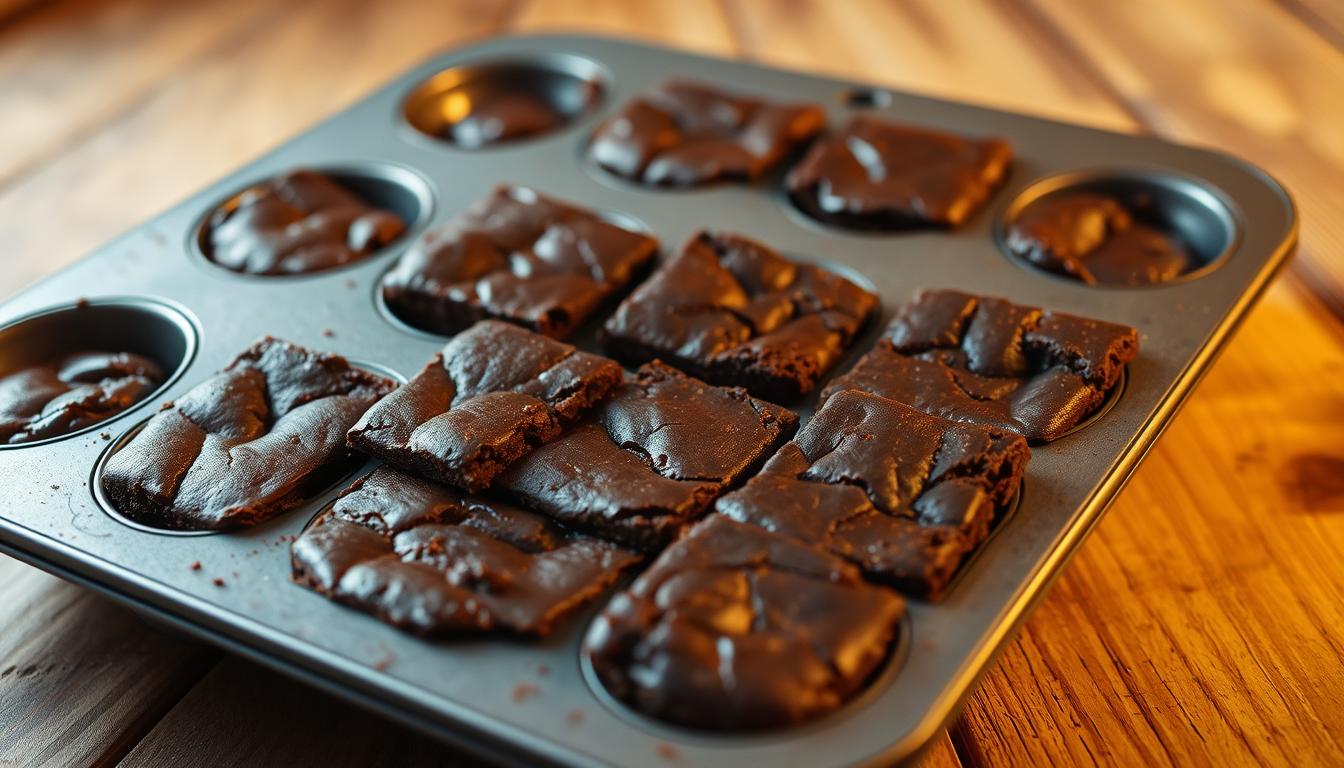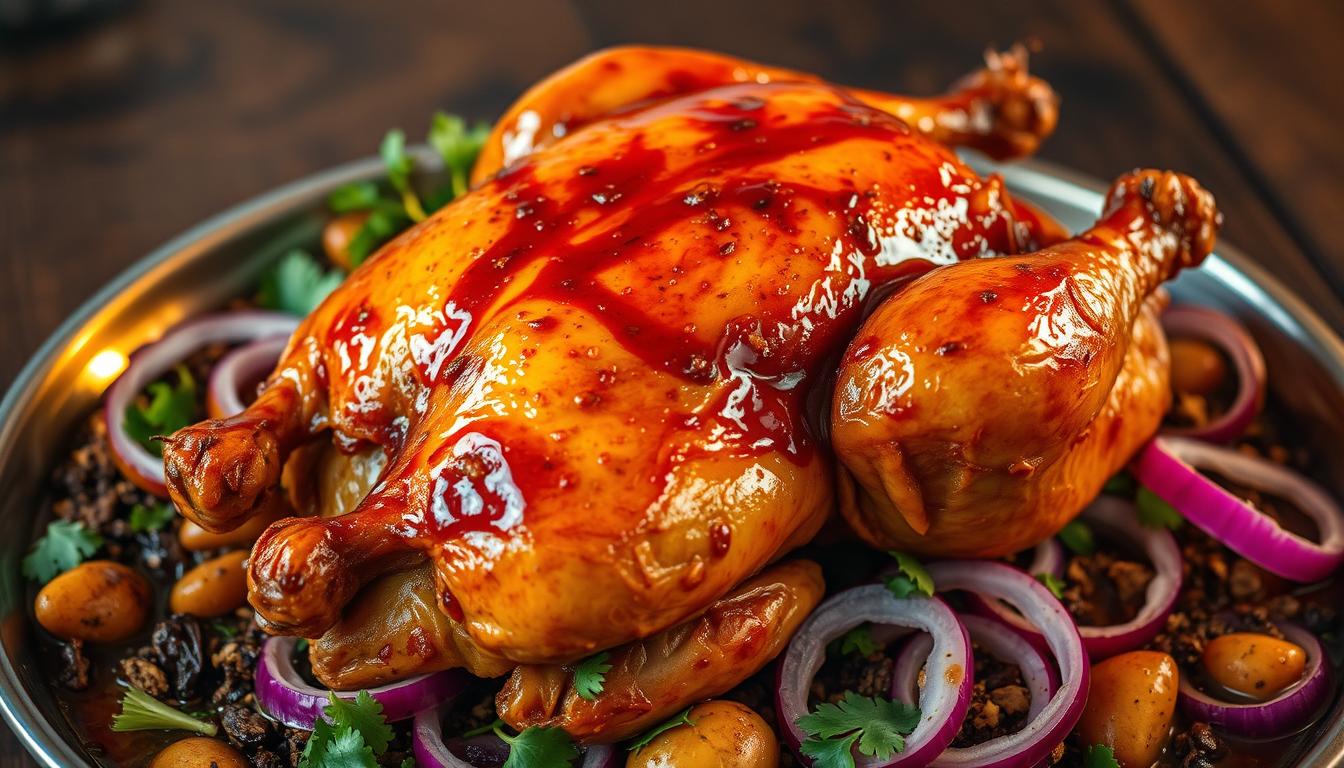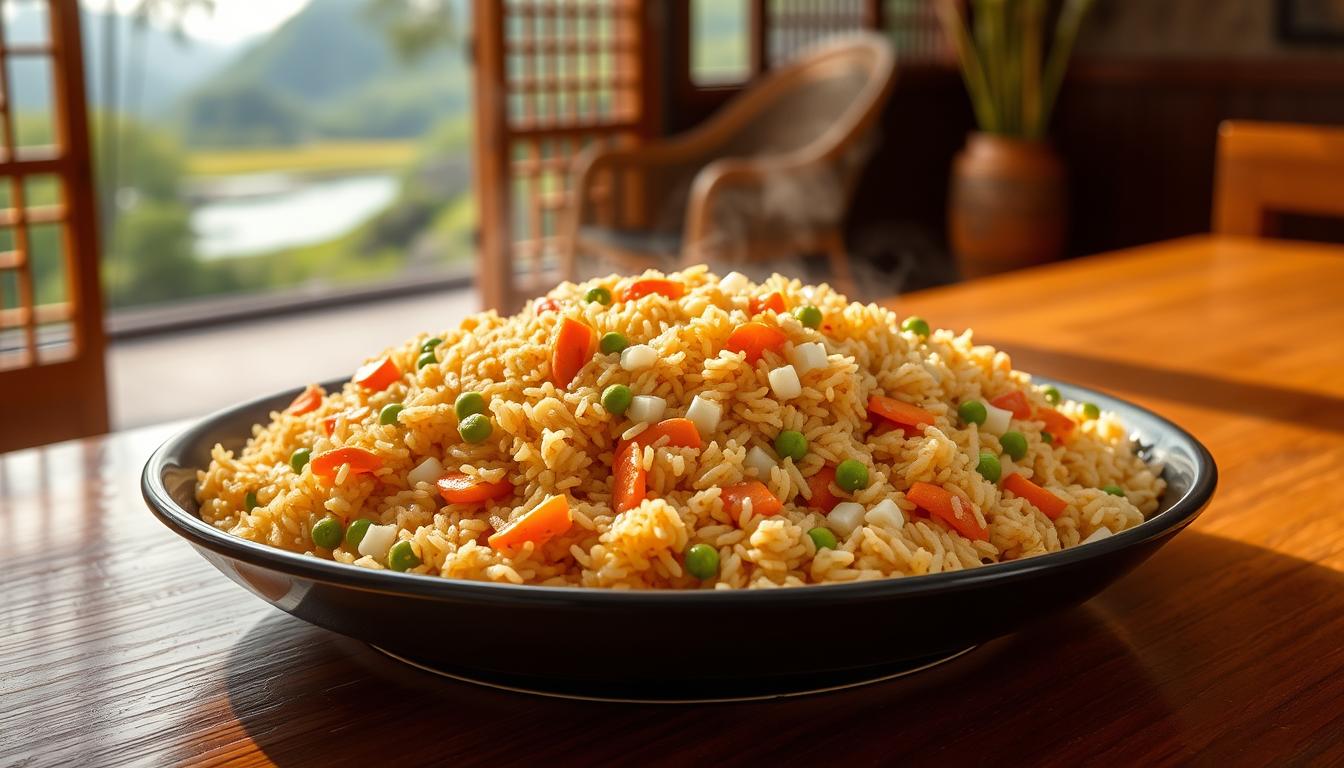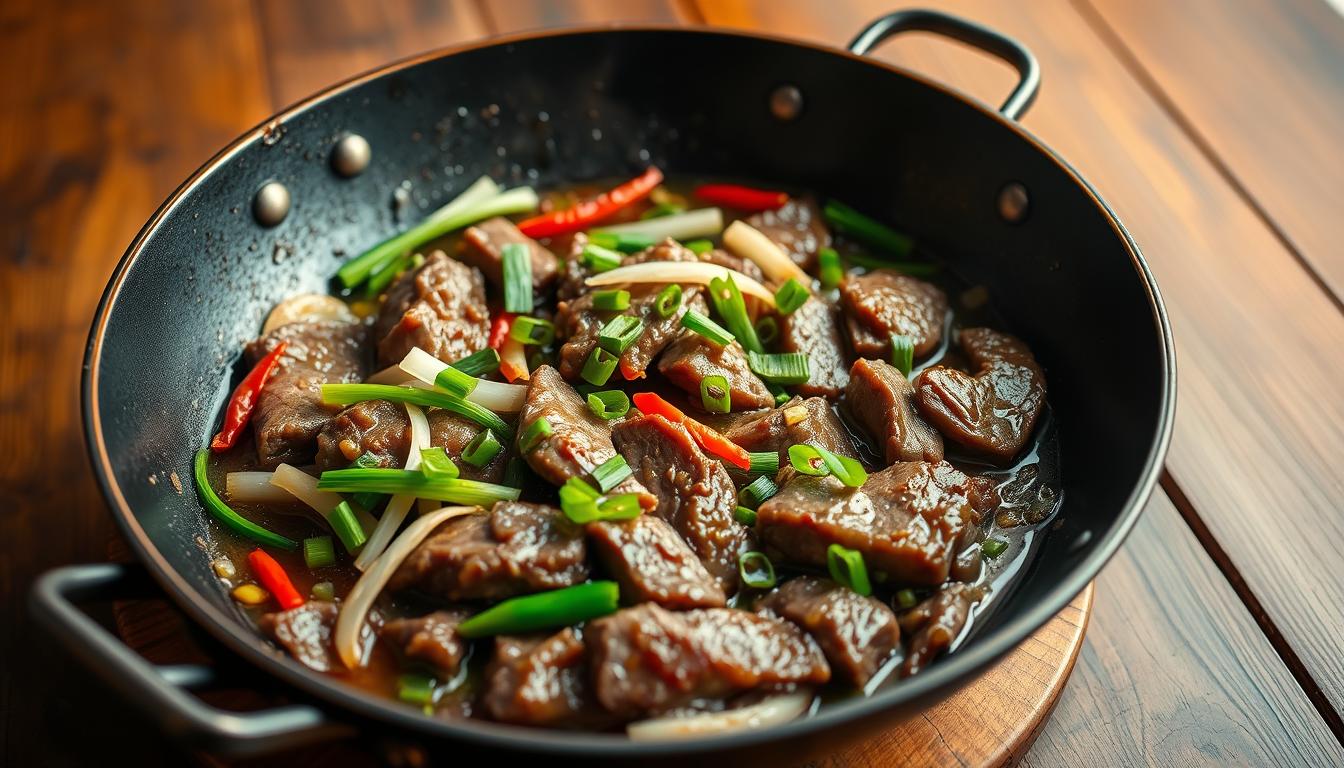The sizzle of vegetables on a hot griddle is mesmerizing. The aromatic steam rising fills the air. It’s like having a restaurant-quality meal at home.
Growing up, I loved visiting our local Japanese steakhouse. Watching chefs turn simple ingredients into art was magical. It was a special time for my family.
Now, I can make easy hibachi vegetables at home. It’s not just cooking; it’s about making those special moments last. With a few simple steps, you can make ordinary vegetables into a feast.
Key Takeaways
- Master the art of hibachi-style vegetable cooking at home
- Learn quick and easy preparation techniques
- Discover the perfect vegetable combinations
- Understand the importance of high-heat cooking
- Create restaurant-quality hibachi vegetables in minutes
Introduction to Hibachi Cooking
Hibachi cooking is a vibrant tradition that turns simple ingredients into a fun dining experience. It’s a Japanese grilling method that has won the hearts of food lovers everywhere. It brings the excitement of restaurant meals into your home kitchen.
This cooking style comes from Japan. It’s known for its special way of grilling veggies and proteins. The method uses a hot flat-top grill or skillet to make tasty meals fast and full of flavor.
What is Hibachi Cooking?
Hibachi cooking is more than just cooking—it’s a show. The traditional way includes:
- Cooking at extremely high temperatures
- Using a flat iron griddle or special grill
- Preparing food quickly with flair
- Focusing on fresh, high-quality ingredients
The Appeal of Hibachi Vegetables
Hibachi veggies are tasty and healthy. The high-heat cooking method enhances their natural sweetness. It also creates a caramelized flavor that’s hard to resist.
| Vegetable | Cooking Time | Flavor Profile |
|---|---|---|
| Zucchini | 3-4 minutes | Mild, slightly sweet |
| Broccoli | 4-5 minutes | Nutty, crisp |
| Mushrooms | 5-6 minutes | Rich, umami |
| Carrots | 3-4 minutes | Sweet, tender |
When you make grilled hibachi veggies at home, you choose the ingredients and seasonings. This lets you make dishes as good as restaurants with little effort and lots of taste.
Essential Vegetables for Hibachi
Starting a delicious hibachi vegetable side dish means picking the right ingredients. Your quick hibachi vegetable stir-fry can turn simple veggies into a special dish.
Hibachi cooking loves fresh, vibrant veggies. They add flavor and nutrition to your meal. The trick is to pick veggies that can handle high heat without losing taste or texture.
Popular Choices for Hibachi Vegetables
Classic hibachi veggies include:
- Zucchini – sliced into short sticks
- Mushrooms – cremini or button varieties work best
- Sweet onions – cut into chunky pieces
- Bell peppers – for color and crunch
- Carrots – sliced thin for quick cooking
Seasonal Vegetables to Enhance Flavor
Change up your veggies with the seasons. Summer brings crisp zucchini and bell peppers. Winter offers hearty Brussels sprouts and butternut squash.
Nutritional Benefits of Hibachi Vegetables
Your quick hibachi vegetable stir-fry is not just tasty—it’s full of nutrients. A serving gives you:
- 80 calories
- 12g carbohydrates
- 3g protein
- 2g fiber
- Vitamins A and C
Choosing the right veggies and cooking them well makes a nutritious, tasty hibachi vegetable side dish. It’s something everyone will enjoy.
Preparing Vegetables for Hibachi
Making a traditional hibachi vegetable recipe needs precision and care. How you prepare your vegetables can make or break the meal. Professional chefs say that the right preparation is key to making delicious hibachi vegetables.
There are important steps to take when preparing vegetables for hibachi cooking. These steps help ensure the vegetables taste great and have the right texture. Let’s look at the main techniques to improve your cooking skills.
How to Cut Vegetables for Even Cooking
Cutting vegetables evenly is crucial for a great hibachi dish. Here are some expert tips:
- Use a sharp knife for precise cuts
- Aim for uniform piece sizes around 1/4 to 1/2 inch thick
- Cut vegetables into similar shapes for consistent cooking
- Slice zucchini, bell peppers, and onions into even strips
Marinating Techniques for Extra Flavor
Marinating can turn simple vegetables into a special hibachi dish. Here are some ways to add more flavor:
- Create a marinade with teriyaki sauce
- Use coconut aminos for a gluten-free option
- Add minced garlic and ginger for depth
- Let vegetables marinate for 15-30 minutes before cooking
The Importance of Drying Vegetables
Drying vegetables might seem small, but it’s key for a perfect sear. Too much moisture stops vegetables from caramelizing and getting rich flavors.
| Vegetable Type | Recommended Drying Method | Cooking Time |
|---|---|---|
| Zucchini | Pat dry with paper towels | 6-8 minutes |
| Mushrooms | Air dry or use kitchen towel | 5-7 minutes |
| Bell Peppers | Blot with clean cloth | 6-8 minutes |
By using these preparation techniques, you’ll make hibachi vegetables that are as good as those in a restaurant. They will surely impress your family and friends.
Key Cooking Techniques
Learning to cook hibachi is all about mastering special techniques. These methods turn simple veggies into amazing dishes. The right cooking ways bring out the best flavors and textures.
High heat is key to making great hibachi veggies. Hibachi grills get hotter than 500°F (260°C). This heat cooks food fast, keeping flavors and nutrients in.
The Role of High Heat in Vegetable Preparation
High-temperature cooking has many benefits for hibachi veggies:
- Quick caramelization of vegetable surfaces
- Retention of crisp texture
- Enhanced natural vegetable sweetness
- Minimal nutrient loss during cooking
Stir-Frying vs. Grilling Techniques
Knowing two main cooking methods can improve your hibachi veggies recipe:
| Stir-Frying | Grilling |
|---|---|
| Constant movement | Direct heat exposure |
| Shorter cooking time | Longer cooking time |
| Ideal for softer vegetables | Best for firm vegetables |
Selecting the Right Cooking Surface
Choosing the right grill matters for your hibachi veggies. A flat-top griddle lets you cook many things at once, like a pro. Use oils like canola or peanut oil for a great sear.
Pro tip: Preheating your cooking surface is crucial for developing rich flavors and achieving beautiful caramelization on your best hibachi veggies.
Flavor Enhancements and Seasoning
Making easy hibachi vegetables is all about mixing flavors and picking the right seasonings. Your cooking will get better when you learn the key things that make veggies taste amazing.
Learning how to make flavorful hibachi vegetables is all about knowing the important parts. These parts add depth and excitement to your dish.
Recommended Oils for Hibachi Cooking
Choosing the right oil is key in hibachi cooking. Here are some top picks:
- Sesame oil for authentic Asian flavor
- Peanut oil for high-heat cooking
- Vegetable oil for neutral taste
- Canola oil for health-conscious cooking
Spices and Herbs to Elevate Your Dish
Boost your easy hibachi vegetables with these powerful flavor enhancers:
- Garlic powder for depth
- Fresh ginger for brightness
- White pepper for subtle heat
- Dried thyme for earthy notes
Sauces to Try for Hibachi Vegetables
| Sauce Name | Flavor Profile | Best Paired Vegetables |
|---|---|---|
| Teriyaki | Sweet and tangy | Zucchini, bell peppers |
| Soy Sauce | Umami and salty | Mushrooms, onions |
| Ginger Dressing | Light and zingy | Mixed vegetable medley |
With these seasonings and sauces, your hibachi vegetables will be a hit. Try different combinations to find your favorite!
Cooking Hibachi Vegetables: Step-by-Step
Making a tasty quick hibachi vegetable stir-fry at home is simple. With the right steps, you can make ordinary veggies into a dish that’s full of flavor and texture.
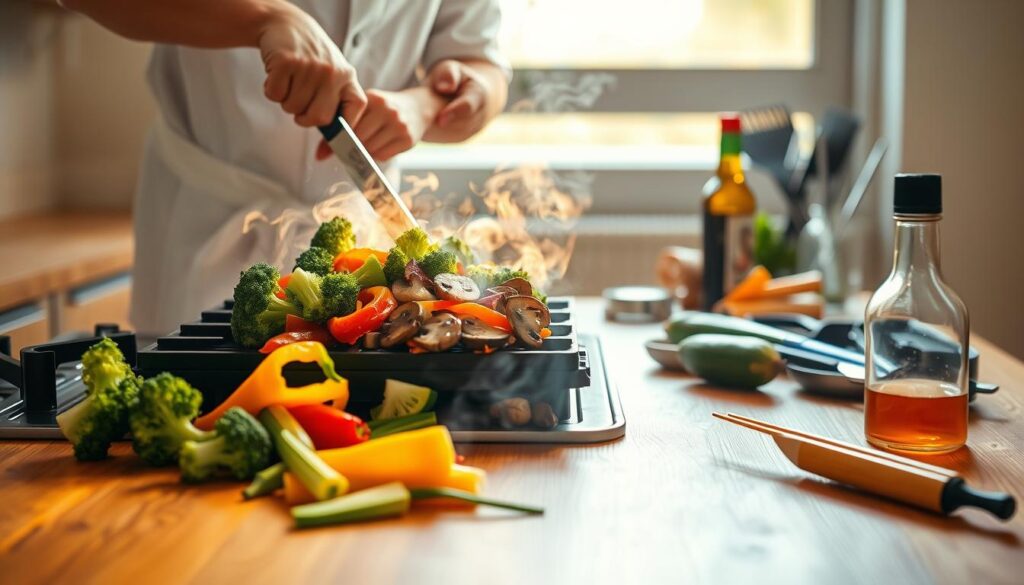
To make homemade hibachi vegetables, you need to pay attention to detail and use the right cooking methods. Here are the key steps to make sure your vegetable stir-fry is perfect every time.
Prepping Your Cooking Surface
First, pick the right cooking surface. A cast-iron skillet or flat-top griddle is best for hibachi-style cooking. Heat it to medium-high, about 400-450°F, for that perfect sear.
- Preheat your cooking surface for 3-5 minutes
- Make sure it’s clean and lightly oiled
- Use avocado or sesame oil for the best results
Cooking Times for Different Vegetables
Each vegetable cooks differently in a quick hibachi vegetable stir-fry. Carrots take longer, while zucchini cooks fast.
- Carrots: 4-5 minutes
- Broccoli: 3-4 minutes
- Zucchini: 2-3 minutes
- Onions: 2-3 minutes
Tips for Achieving the Perfect Sear
To get that perfect caramelized look, don’t overcrowd the cooking surface. Cook in batches so each veggie can brown well.
- Cut veggies into uniform sizes
- Cook in small batches
- Stir minimally to get a golden-brown crust
- Season with garlic powder and coconut aminos
By using these tips, you’ll make a delicious homemade hibachi vegetable dish that’s just as good as your favorite restaurant’s.
Hibachi Vegetables Combination Ideas
Making a memorable hibachi vegetable dish is more than just cooking veggies. It’s about creating a balanced, beautiful meal that pleases both taste and sight.
Turn your traditional hibachi vegetable recipe into a full meal with smart pairings. Here are some ways to make your hibachi vegetable dish stand out:
Creating a Colorful Vegetable Medley
A vibrant hibachi vegetable medley should have different colors and textures. Try mixing:
- Broccoli florets (bright green)
- Sliced mushrooms (earthy brown)
- Bright orange carrots
- White onions
- Red bell peppers
Pairing Vegetables with Proteins
Pair your hibachi veggies with proteins for a hearty meal. Some great pairings are:
- Chicken with zucchini and green beans
- Beef with bell peppers and onions
- Shrimp with bok choy and water chestnuts
Adding Rice or Noodles to Your Meal
Make your hibachi vegetable dish a full meal by adding rice or noodles. Fried rice is especially good, adding a savory base that enhances the veggies’ flavors.
Pro tip: Use day-old rice for the best fried rice texture in your traditional hibachi vegetable recipe.
With these ideas, you’ll make a hibachi vegetable dish that’s not only healthy but also amazing to look at and eat.
Common Mistakes to Avoid
Mastering easy hibachi vegetables is more than just skill. It’s about paying attention to detail. Even experienced cooks can make mistakes when making the best hibachi veggies. Knowing what to avoid helps you make dishes that taste like they’re from a restaurant.
Cooking hibachi vegetables is an art that needs precision and technique. The biggest mistakes can ruin your meal.
Overcooking vs. Undercooking
Getting the right texture is key for easy hibachi vegetables. Overcooking makes them mushy and flavorless. Undercooking makes them hard and unappetizing.
- Overcooking symptoms:
- Vegetables lose vibrant colors
- Texture becomes soft and mushy
- Nutrients and flavor diminish
- Undercooking symptoms:
- Vegetables remain tough
- Raw, crunchy texture
- Difficult to chew
Choosing the Wrong Vegetables
Not all vegetables are good for hibachi dishes. Picking the right ones ensures great flavor and texture.
| Recommended Vegetables | Not Recommended |
|---|---|
| Zucchini | Eggplant |
| Bell Peppers | Bitter Squash |
| Onions | Watery Vegetables |
| Mushrooms | Leafy Greens |
Not Prepping in Advance
Proper preparation is essential for easy hibachi vegetables. Not prepping can cause uneven cooking and frustration.
- Wash vegetables thoroughly
- Cut vegetables uniformly
- Pat dry to remove excess moisture
- Marinate if desired
- Have all ingredients ready before cooking
Pro tip: Mise en place—having all ingredients prepared and ready—is crucial for successful hibachi cooking.
Avoiding these mistakes will help you make delicious, restaurant-quality hibachi vegetables. They’ll impress your family and friends.
Serving Suggestions
To make your grilled hibachi veggies stand out, focus on how you present them. The right way to serve can turn a simple side dish into a memorable meal.
Presentation Tips for Hibachi Vegetables
Creating a beautiful plate of grilled hibachi veggies is more than cooking. Here are some tips for presentation:
- Use a large, white ceramic plate to make colors pop
- Arrange vegetables in a circular or geometric pattern
- Garnish with fresh herbs like cilantro or green onions
- Drizzle a light sauce for added visual appeal
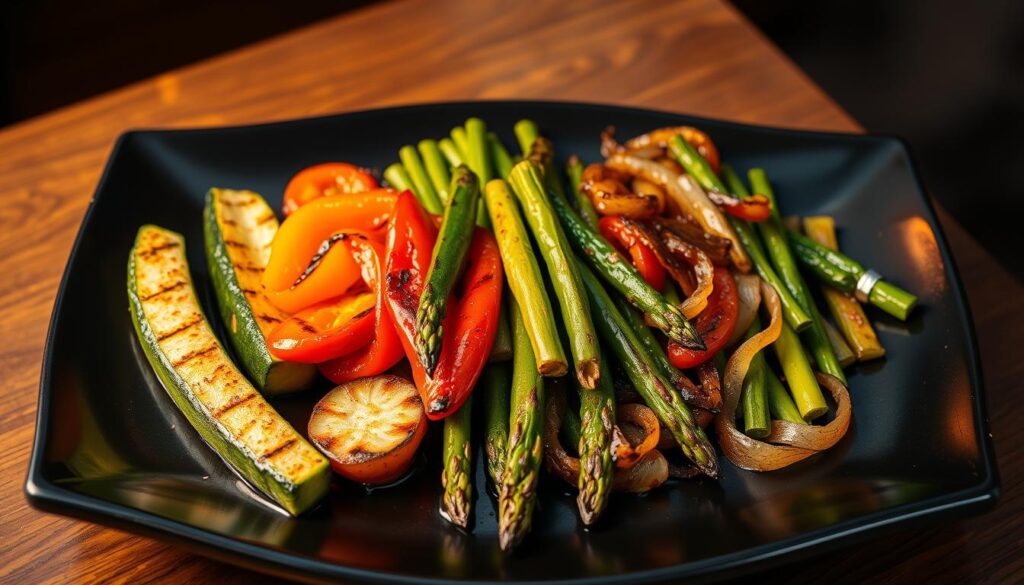
Ideal Side Dishes to Complement Your Meal
Choosing the right sides can make your meal even better. Here are some great options:
| Side Dish | Flavor Profile | Recommended Pairing |
|---|---|---|
| Steamed Rice | Neutral, Starchy | Perfect base for hibachi vegetables |
| Miso Soup | Umami, Savory | Balances grilled vegetable flavors |
| Edamame | Light, Protein-Rich | Adds texture to the meal |
Pairing with Beverages for the Perfect Meal
Your hibachi veggies deserve a great drink to go with them. Here are some drink suggestions:
- Green Tea: Cleanses the palate between bites
- Sake: Traditional Japanese rice wine
- Light Japanese beer
- Crisp white wine
“The art of serving hibachi is not just about cooking, but creating an experience that delights all senses.”
Vegetarian and Vegan Options
Turning your hibachi vegetables into a plant-based dish is exciting. It lets you try new things with protein and cooking methods. This way, vegetarian and vegan diners can enjoy tasty hibachi vegetables.
Plant-based proteins can make your hibachi vegetables even better. They add nutrition and flavor. Here are some tasty options to make your meal satisfying and healthy.
Plant-Based Protein Additions
For a vegan hibachi vegetables recipe, try these protein-rich foods:
- Extra firm tofu (marinated for maximum flavor)
- Tempeh with robust texture
- Seitan for a meat-like consistency
- Edamame for quick protein boost
Creative Ways to Include More Greens
Make your hibachi vegetables more interesting with different greens:
- Baby spinach
- Kale strips
- Bok choy
- Asian green beans
Flavorful Vegan Sauces for Hibachi
Try these tasty sauces for your plant-based hibachi:
- Miso-Ginger Sauce: Combines umami with zesty notes
- Coconut Amino Glaze: Sweet and tangy alternative to soy sauce
- Sesame-Tamari Reduction: Rich, nutty flavor profile
With these tips, you can make a vegan hibachi dish that everyone will love. It keeps the authentic flavors and textures.
Storing Leftovers
After making your tasty homemade hibachi vegetables, it’s key to know how to store leftovers. This helps keep flavors strong and reduces waste. By storing leftovers right, you can enjoy your quick hibachi vegetable stir-fry for days.
Best Practices for Storing Hibachi Vegetables
Keeping your hibachi vegetables fresh is vital. Here are some important tips:
- Cool vegetables completely before storing
- Use airtight containers with tight-fitting lids
- Store in the refrigerator for 3-4 days maximum
- Separate wet and dry ingredients to prevent sogginess
Reheating Techniques for Optimal Taste
When reheating hibachi vegetables, warm them gently. Avoid microwave reheating when possible, as it can make them mushy and tasteless.
- Use a skillet on medium-high heat
- Add a small amount of oil
- Stir-fry for 2-3 minutes until heated through
- Season lightly to refresh flavors
Creative Ways to Use Leftovers
Turn your leftover hibachi vegetables into new dishes. Here are some ideas:
- Quick hibachi vegetable stir-fry with added protein
- Wrap filling for lunch
- Topping for salads or grain bowls
- Omelet or frittata ingredient
By using these storage and reheating tips, you’ll enjoy your homemade hibachi vegetables more. And you’ll waste less food.
Conclusion: Mastering the Art of Hibachi
Starting your hibachi cooking journey turns simple veggies into a fun adventure. It’s not just about following a recipe; it’s about passion and creativity. With time, you’ll get better at making delicious hibachi veggies that impress everyone.
Every chef begins with a blank slate, and mastering hibachi takes patience and trying new things. The 15-17 minutes of cooking time is a chance to play with flavors and textures. Think of your grill as a canvas, where each veggie brings its own taste to the table.
Don’t be afraid to find your own style in hibachi cooking. Your skills will grow with each dish you make, making every meal special. Start with simple recipes, learn from your mistakes, and soon you’ll be making dishes that wow.
Keep exploring hibachi cooking with an open mind and trust your taste. This cooking method is all about being flexible and expressing yourself. Your next hibachi dish might become a family favorite.
FAQ
What vegetables work best for hibachi-style cooking?
Great vegetables for hibachi include zucchini, bell peppers, onions, mushrooms, and carrots. They handle high heat well and soak up flavors. Try adding seasonal veggies like asparagus or broccoli for more variety.
Do I need a special hibachi grill to make hibachi vegetables at home?
No, you don’t need a traditional hibachi grill. Use a cast-iron skillet, flat-top griddle, or outdoor grill. High heat and quick cooking keep veggies crisp.
How can I prevent my vegetables from becoming soggy when cooking?
To avoid soggy veggies, pat them dry before cooking. Use high heat and don’t overcrowd the cooking area. Cook in batches if needed, and avoid too much liquid. Aim for a slight char to keep veggies crisp.
What are the essential seasonings for authentic hibachi vegetables?
Essential seasonings include soy sauce, garlic, sesame oil, and butter. Ginger, salt, and black pepper also enhance flavor. These ingredients create the classic hibachi taste.
How long should I cook hibachi vegetables?
Cook most veggies for 3-5 minutes to get a slight char and crisp texture. Carrots might need a bit longer, while mushrooms cook faster.
Can I make hibachi vegetables vegetarian or vegan?
Yes! Hibachi veggies are naturally vegetarian. For vegan, use plant-based butter or olive oil and tamari instead of soy sauce. Adding tofu or plant-based protein makes it more filling.
How do I store leftover hibachi vegetables?
Store leftovers in an airtight container in the fridge for 3-4 days. Reheat in a skillet or wok to keep them crispy. Avoid microwaving to prevent sogginess.
What proteins pair well with hibachi vegetables?
Pair veggies with chicken, shrimp, beef, or tofu. These proteins cook well with veggies, making a complete, flavorful meal.

